Text

Omega Sunrise
Capturing this sunrise required both luck and timing. First and foremost, precise timing was needed to capture a sailboat crossing right in front of a rising Sun. Additionally, by a lucky coincidence, the background Sun itself appears unusual -- it looks like the Greek letter Omega (?). In reality, the Sun remained its circular self -- the Omega illusion was created by sunlight refracting through warm air just above the water. Optically, the feet of the capital Omega are actually an inverted image of the Sun region just above it. Although somewhat rare, optical effects caused by the Earth's atmosphere can make distant objects near the horizon -- including the Sun and Moon -- look quite unusual. This single exposure image was taken over the Mediterranean Sea just over two weeks ago near Valencia, Spain.
Image Credit & Copyright: Juan Antonio Sendra
#nasa picture of the day#awesome#beautiful pics#beautiful#picoftheday#photography#science#astronomy#space#space news
35 notes
·
View notes
Text
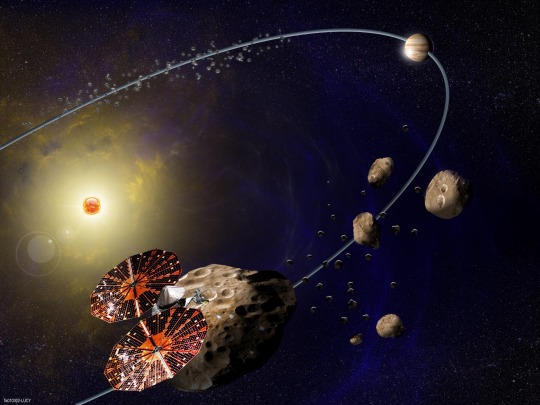
Lucy Mission
NASA's Lucy mission, which will launch in 2021 for the first reconnaissance of the Trojans, a population of primitive asteroids orbiting in tandem with Jupiter. In this artist's concept (not to scale), the Lucy spacecraft is flying by Eurybates, one of the six diverse and scientifically important Trojans to be studied. Credits: Southwest Research Institute
#nasa picture of the day#awesome#beautiful pics#beautiful#picoftheday#photography#science#astronomy#space#space news
5 notes
·
View notes
Text

A Zodiacal Sky over Horseshoe Bend
What's causing the unusual ray of white light extending upward from the central horizon? Dust orbiting the Sun. At certain times of the year, a band of sun-reflecting dust from the inner Solar System rises prominently before sunrise and is called zodiacal light. The dust originates mostly from faint Jupiter-family comets and slowly spirals into the Sun. Pictured, in front of the zodiacal light, is a spectacular view of Horseshoe Bend of the Colorado River. Emitted from well behind the zodiacal light is a spectacular sky that includes many bright stars including Sirius, several blue star clusters including the Pleiades, and an assortment of red nebula including Barnard's Loop in Orion. The 30-image composite was taken earlier this month in nearly complete darkness only six inches from the edge of a dangerous cliff.
Image Credit & Copyright: David Lane
#nasa picture of the day#awesome#beautiful pics#beautiful#picoftheday#photography#science#astronomy#space#space news
6 notes
·
View notes
Text

Breaking Distant Light
In the distant universe, time appears to run slowly. Since time-dilated light appears shifted toward the red end of the spectrum (redshifted), astronomers are able to use cosmological time-slowing to help measure vast distances in the universe. Featured, the light from distant galaxies has been broken up into its constituent colors (spectra), allowing astronomers to measure the cosmological redshift of known spectral lines. The novelty of the featured image is that the distance to hundreds of galaxies can be measured from a single frame, in this case one taken by the Visible MultiObject Spectrograph (VIMOS) operating at the Very Large Telescope (VLT) array in Chile. Analyzing the space distribution of distant objects will allow insight into when and how stars and galaxies formed, clustered, and evolved in the early universe.
Image Copyright: Image Credit: VIMOS, VLT, ESO
#nasa picture of the day#awesome#beautiful pics#beautiful#picoftheday#photography#science#astronomy#space#space news
0 notes
Text

Planets on the Wing
Lately, bright Jupiter and fainter Mars have been easy to spot for early morning skygazers. Before dawn on January 7 the two naked-eye planets will reach a close conjunction near the horizon, only 1/4 degree apart in predawn eastern skies. That apparent separation corresponds to about half the angular diameter of a Full Moon. Just off the wing of a high-flying aircraft in this snapshot from early morning January 5, Jupiter (left) and Mars (middle) are also lined-up with the well-balanced Zubenelgenubi (right), alpha star of the constellation Libra. Below are lights from central Europe near Prague, Czech Republic, planet Earth.
Image Credit & Copyright: Dong Han
#nasa picture of the day#awesome#beautiful pics#beautiful#picoftheday#photography#science#astronomy#space#space news
3 notes
·
View notes
Text
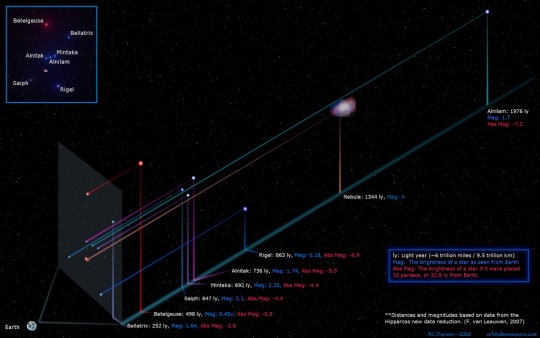
Orion in Depth
Orion is a familiar constellation. The apparent positions of its stars in two dimensions create a well-known pattern on the bowl of planet Earth's night sky. Orion may not look quite so familiar in this 3D view though. The illustration reconstructs the relative positions of Orion's bright stars, including data from the Hipparcus catalog of parallax distances. The most distant star shown is Alnilam. The middle one in the projected line of three that make up Orion's belt when viewed from planet Earth, Alnilam is nearly 2,000 light-years away, almost 3 times as far as fellow belt stars Alnitak and Mintaka. Though Rigel and Betelgeuse apparently shine brighter in planet Earth's sky, that makes more distant Alnilam intrinsically (in absolute magnitude) the brightest of the familiar stars in Orion. In the Hipparcus catalog, errors in measured parallaxes for Orion's stars can translate in to distance errors of a 100 light-years or so.
Image Copyright: Ronald Davison
#nasa picture of the day#awesome#beautiful pics#beautiful#picoftheday#photography#science#astronomy#space#space news
7 notes
·
View notes
Text
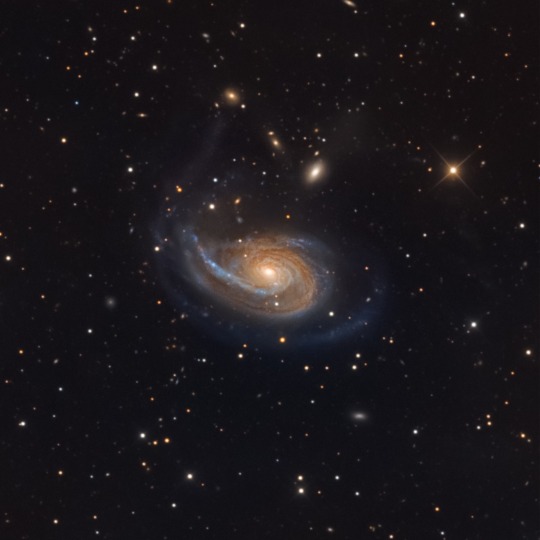
Arp 78: Peculiar Galaxy in Aries
(xxxedit and linkxxx) Peculiar spiral galaxy Arp 78 is found within the boundaries of the head strong constellation Aries, some 100 million light-years beyond the stars and nebulae of our Milky Way galaxy. Also known as NGC 772, the island universe is over 100,000 light-years across and sports a single prominent outer spiral arm in this detailed cosmic portrait. Its brightest companion galaxy, compact NGC 770, is toward the upper right of the larger spiral. NGC 770's fuzzy, elliptical appearance contrasts nicely with a spiky foreground Milky Way star in matching yellowish hues. Tracking along sweeping dust lanes and lined with young blue star clusters, Arp 78's large spiral arm is likely due to gravitational tidal interactions. Faint streams of material seem to connect Arp 78 with its nearby companion galaxies.
Image Copyright: Bernard Miller
#nasa picture of the day#awesome#beautiful pics#beautiful#picoftheday#photography#science#astronomy#space#space news
2 notes
·
View notes
Text
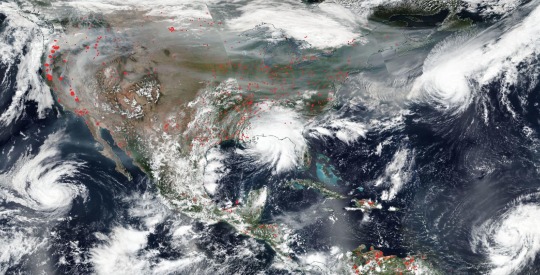
NASA Image Shows Fires, Hurricanes Across the U.S.
NASA's Aqua satellite captured this true-color image of the United States on Sep. 15, 2020, showing the fires in the West, the smoke from those fires drifting over the country, several hurricanes converging from different angles, and Hurricane Sally making landfall. Red points in the west note areas that are significantly higher in temperature than the areas around it and are indicative of fires. These points are most pronounced up and down the West Coast, but dot the country from coast-to-coast as well. In addition, in this image are captured four hurricanes/tropical storms in both the East and the West. On the left hand side is Karina which is moving away from the Baja California area. Hurricane Sally, seen in the middle of the image, made landfall overnight on the Gulf Coast bringing catastrophic flooding in its wake. Hurricane Paulette sits off the East Coast near Bermuda with winds of 74 mph, although no landmasses are threatened. Hurricane Teddy, in the lower right hand corner is east of the Leeward Islands, also has sustained winds of 74 mph, and is traveling westnorthwest. Satellite images are generated every single day, in fact multiple times from multiple satellites, but it is still very unusual to capture an image of so many hazards in one image.
For more than five decades, NASA has used the vantage point of space to understand and explore our home planet, improve lives and safeguard our future. NASA brings together technology, science, and unique global Earth observations to provide societal benefits and strengthen our nation. Advancing knowledge of our home planet contributes directly to America's leadership in space and scientific exploration.
Credit: NASA Worldview, Earth Observing System Data and Information System.
#nasa picture of the day#awesome#beautiful pics#beautiful#picoftheday#photography#science#astronomy#space#space news
0 notes
Text

Gravel Ejected from Asteroid Bennu
Why does asteroid Bennu eject gravel into space? No one is sure. The discovery, occurring during several episodes by NASA's visiting ORISIS-REx spacecraft, was unexpected. Leading ejection hypotheses include impacts by Sun-orbiting meteoroids, sudden thermal fractures of internal structures, and the sudden release of a water vapor jet. The featured two-image composite shows an ejection event that occurred in early 2019, with sun-reflecting ejecta seen on the right. Data and simulations show that large gravel typically falls right back to the rotating 500-meter asteroid, while smaller rocks skip around the surface, and the smallest rocks completely escape the low gravity of the Earth approaching, diamond-shaped asteroid. Jets and surface ejection events were thought to be predominantly the domain of comets, responsible for their tails, comas, and later meteor showers on Earth. Robotic OSIRIS-REx arrived at 101955 Bennu in late 2018, and is planned to touchdown to collect a surface sample in October 2020. If all goes well, this sample will then be returned to Earth for a detailed analysis during 2023. Bennu was chosen as the destination for OSIRIS-REx in part because its surface shows potential to reveal organic compounds from the early days of our Solar System, compounds that could have been the building blocks for life on Earth.
Image Copyright: Image Credit: NASA s GSFC, U. Arizona, OSIRIS-REx Lockheed Martin
#nasa picture of the day#awesome#beautiful pics#beautiful#picoftheday#photography#science#astronomy#space#space news
1 note
·
View note
Text

A New View of Jupiter's Storms
This latest image of Jupiter, taken by NASA's Hubble Space Telescope on Aug. 25, 2020, was captured when the planet was 406 million miles from Earth. Hubble's sharp view is giving researchers an updated weather report on the monster planet's turbulent atmosphere, including a remarkable new storm brewing, and a cousin of the famous Great Red Spot region gearing up to change color – again.
A unique and exciting detail of Hubble's snapshot appears at mid-northern latitudes as a bright, white, stretched-out storm traveling around the planet at 350 miles per hour (560 kilometers per hour). This single plume erupted on Aug. 18, 2020 – and ground-based observers have discovered two more that appeared later at the same latitude.
While it's common for storms to pop up in this region every six years or so, often with multiple storms at once, the timing of the Hubble observations is perfect for showing the structure in the wake of the disturbance, during the early stages of its evolution. Trailing behind the plume are small, rounded features with complex "red, white, and blue" colors in Hubble's ultraviolet, visible, and near-infrared light image. Such discrete features typically dissipate on Jupiter, leaving behind only changes in cloud colors and wind speeds, but a similar storm on Saturn led to a long-lasting vortex. The differences in the aftermaths of Jupiter and Saturn storms may be related to the contrasting water abundances in their atmospheres, since water vapor may govern the massive amount of stored-up energy that can be released by these storm eruptions.
Hubble shows that the Great Red Spot, rolling counterclockwise in the planet's southern hemisphere, is plowing into the clouds ahead of it, forming a cascade of white and beige ribbons. The Great Red Spot is currently an exceptionally rich red color, with its core and outermost band appearing deeper red.
Researchers say the Great Red Spot now measures about 9,800 miles across, big enough to swallow Earth. The super-storm is still shrinking as noted in telescopic observations dating back to 1930, but the reason for its dwindling size is a complete mystery.
Another feature researchers are noticing has changed is Oval BA, nicknamed by astronomers as Red Spot Jr., which appears just below the Great Red Spot in this image. For the past few years, Red Spot Jr. has been fading in color to its original shade of white after appearing red in 2006. However, now the core of this storm appears to be darkening slightly. This could hint that Red Spot Jr. is on its way to turning to a color more similar to its cousin once again.
Hubble's image shows that Jupiter is clearing out its higher altitude white clouds, especially along the planet's equator, where an orangish hydrocarbon smog wraps around it.
The icy moon Europa, thought to hold potential ingredients for life, is visible to the left of the gas giant.
This Hubble image is part of yearly maps of the entire planet taken as part of the Outer Planets Atmospheres Legacy program, or OPAL. The program provides annual Hubble global views of the outer planets to look for changes in their storms, winds, and clouds.
The Hubble Space Telescope is a project of international cooperation between NASA and ESA (European Space Agency). NASA's Goddard Space Flight Center in Greenbelt, Maryland, manages the telescope. The Space Telescope Science Institute (STScI) in Baltimore conducts Hubble science operations. STScI is operated for NASA by the Association of Universities for Research in Astronomy in Washington, D.C.
#nasa picture of the day#awesome#beautiful pics#beautiful#picoftheday#photography#science#astronomy#space#space news
16 notes
·
View notes
Text

M2-9: Wings of a Butterfly Nebula
Are stars better appreciated for their art after they die? Actually, stars usually create their most artistic displays as they die. In the case of low-mass stars like our Sun and M2-9 pictured here, the stars transform themselves from normal stars to white dwarfs by casting off their outer gaseous envelopes. The expended gas frequently forms an impressive display called a planetary nebula that fades gradually over thousands of years. M2-9, a butterfly planetary nebula 2100 light-years away shown in representative colors, has wings that tell a strange but incomplete tale. In the center, two stars orbit inside a gaseous disk 10 times the orbit of Pluto. The expelled envelope of the dying star breaks out from the disk creating the bipolar appearance. Much remains unknown about the physical processes that cause and shape planetary nebulae.
Image Copyright: Image Credit: Hubble Legacy Archive, NASA, ESA - Processing: Judy Schmidt
#nasa picture of the day#awesome#beautiful pics#beautiful#picoftheday#photography#science#astronomy#space#space news
11 notes
·
View notes
Text
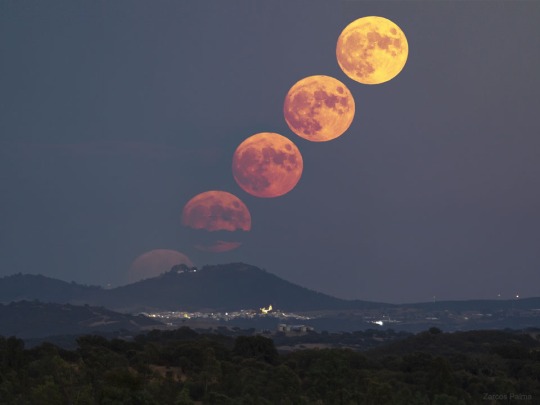
Corn Moon Rising
A rising moon can be a dramatic sight. A rising Full Corn Moon was captured early this month in time-lapse with a telephoto lens from nearly 30 kilometers away -- making Earth's ascending half-degree companion appear unusually impressive. The image was captured from Portugal, although much of the foreground -- including lights from the village of Puebla de Guzmán -- is in Spain. A Full Corn Moon is the name attributed to a full moon at this time of year by cultures of some northern indigenous peoples of the Americas, as it coincides with the ripening of corn. Note that the Moon does not appear larger when it is nearer the horizon -- its seemingly larger size there is only an illusion. The next full moon -- occurring at the beginning of next month -- will be known as the Full Harvest Moon as it occurs nearest in time to the northern autumnal equinox and the northern field harvests.
Image Credit & Copyright: Zarcos Palma
#nasa picture of the day#awesome#beautiful pics#beautiful#picoftheday#photography#science#astronomy#space#space news
6 notes
·
View notes
Text

Hubble Stows a Pocketful of Stars
Many colorful stars are packed close together in this image of the globular cluster NGC 1805, taken by the NASA/ESA Hubble Space Telescope. This tight grouping of thousands of stars is located near the edge of the Large Magellanic Cloud, a satellite galaxy of our own Milky Way. The stars orbit closely to one another, like bees swarming around a hive. In the dense center of one of these clusters, stars are 100 to 1,000 times closer together than the nearest stars are to our Sun, making planetary systems around them unlikely.
The striking difference in star colors is illustrated beautifully in this image, which combines different types of light: blue stars, shining brightest in near-ultraviolet light, and red stars, illuminated in red and near-infrared. Space telescopes like Hubble can observe in the ultraviolet because they are positioned above Earth's atmosphere, which absorbs most ultraviolet light, making it inaccessible to ground-based facilities.
This young globular cluster can be seen from the Southern Hemisphere, in the Dorado constellation, which is Portuguese for dolphinfish. Usually, globular clusters contain stars that are born at the same time. NGC 1805, however, is unusual as it appears to host two different populations of stars with ages millions of years apart. Observing such clusters of stars can help astronomers understand how stars evolve, and what factors determine whether they end their lives as white dwarfs or explode as supernovae.
Text credit: ESA (European Space Agency)
Image credit: ESA/Hubble & NASA, J. Kalirai
#nasa picture of the day#awesome#beautiful pics#beautiful#picoftheday#photography#science#astronomy#space#space news
5 notes
·
View notes
Text
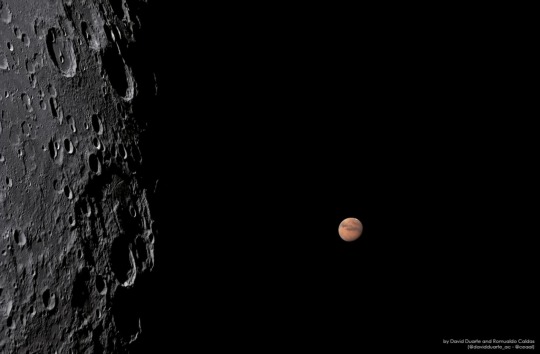
The Reappearance of Mars
Mars reappears just beyond the Moon's dark limb in this stack of sharp video frames captured on September 6. Of course to reappear it had to disappear in the first place. It did that over an hour earlier when the sunlit southern edge of the waning gibbous Moon passed in front of the Red Planet as seen from Maceio, Brazil. The lunar occultation came as the Moon was near apogee, about 400,000 kilometers away. Mars was almost 180 times more distant. It was the fourth lunar occultation of Mars visible from planet Earth in 2020. Visible from some southern latitudes, the fifth lunar occultation of Mars in 2020 will take place on October 3 when the Moon and Mars are both nearly opposite the Sun in planet Earth's sky.
Image Copyright: David Duarte
#nasa picture of the day#awesome#beautiful pics#beautiful#picoftheday#photography#science#astronomy#space#space news
3 notes
·
View notes
Text
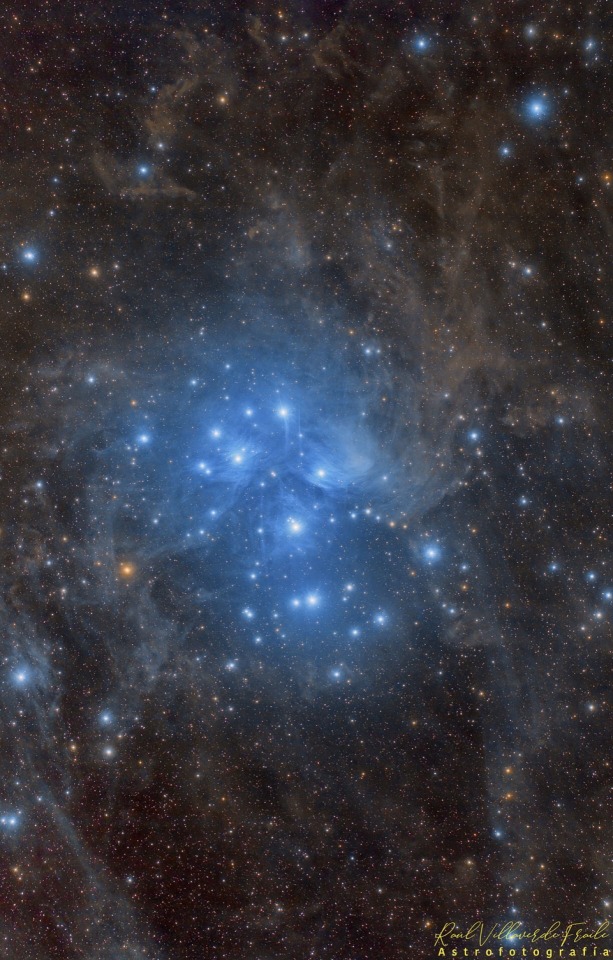
Pleiades: The Seven Sisters Star Cluster
Have you ever seen the Pleiades star cluster? Even if you have, you probably have never seen it as large and clear as this. Perhaps the most famous star cluster on the sky, the bright stars of the Pleiades can be seen without binoculars from even the depths of a light-polluted city. With a long exposure from a dark location, though, the dust cloud surrounding the Pleiades star cluster becomes very evident. The featured exposure covers a sky area several times the size of the full moon. Also known as the Seven Sisters and M45, the Pleiades lies about 400 light years away toward the constellation of the Bull (Taurus). A common legend with a modern twist is that one of the brighter stars faded since the cluster was named, leaving only six of the sister stars visible to the unaided eye. The actual number of Pleiades stars visible, however, may be more or less than seven, depending on the darkness of the surrounding sky and the clarity of the observer's eyesight.
Image Credit & Copyright: Raul Villaverde Fraile
#nasa picture of the day#awesome#beautiful pics#beautiful#picoftheday#photography#science#astronomy#space#space news
6 notes
·
View notes
Text

The Milky Way over St Michael's Mount
Where do land and sky converge? On every horizon -- but in this case the path on the ground leads to St Michael's Mount (Cornish: Karrek Loos yn Koos), a small historic island in Cornwall, England. The Mount is usually surrounded by shallow water, but at low tide is spanned by a human-constructed causeway. The path on the sky, actually the central band of our Milky Way Galaxy, also appears to lead to St Michael's Mount, but really lies far in the distance. The red nebula in the Milky Way, just above the castle, is the Lagoon Nebula, while bright Jupiter shines to the left, and a luminous meteor flashes to the right. The foreground and background images of this featured composite were taken on the same July night and from the same location. Although meteors are fleeting and the Milky Way disk shifts in the night as the Earth turns, Jupiter will remain prominent in the sunset sky into December.
Image Copyright: Image Credit: Simon R. Hudson
#nasa picture of the day#awesome#beautiful pics#beautiful#picoftheday#photography#science#astronomy#space#space news
2 notes
·
View notes
Text

M1: The Crab Nebula from Hubble
This is the mess that is left when a star explodes. The Crab Nebula, the result of a supernova seen in 1054 AD, is filled with mysterious filaments. The filaments are not only tremendously complex, but appear to have less mass than expelled in the original supernova and a higher speed than expected from a free explosion. The featured image, taken by the Hubble Space Telescope, is presentedi in three colors chosen for scientific interest. The Crab Nebula spans about 10 light-years. In the nebula's very center lies a pulsar: a neutron star as massive as the Sun but with only the size of a small town. The Crab Pulsar rotates about 30 times each second.
Image Copyright: Image Credit: NASA, ESA, Hubble, J. Hester, A. Loll (ASU)
#nasa picture of the day#awesome#beautiful pics#beautiful#picoftheday#photography#science#astronomy#space#space news#milkyway
3 notes
·
View notes